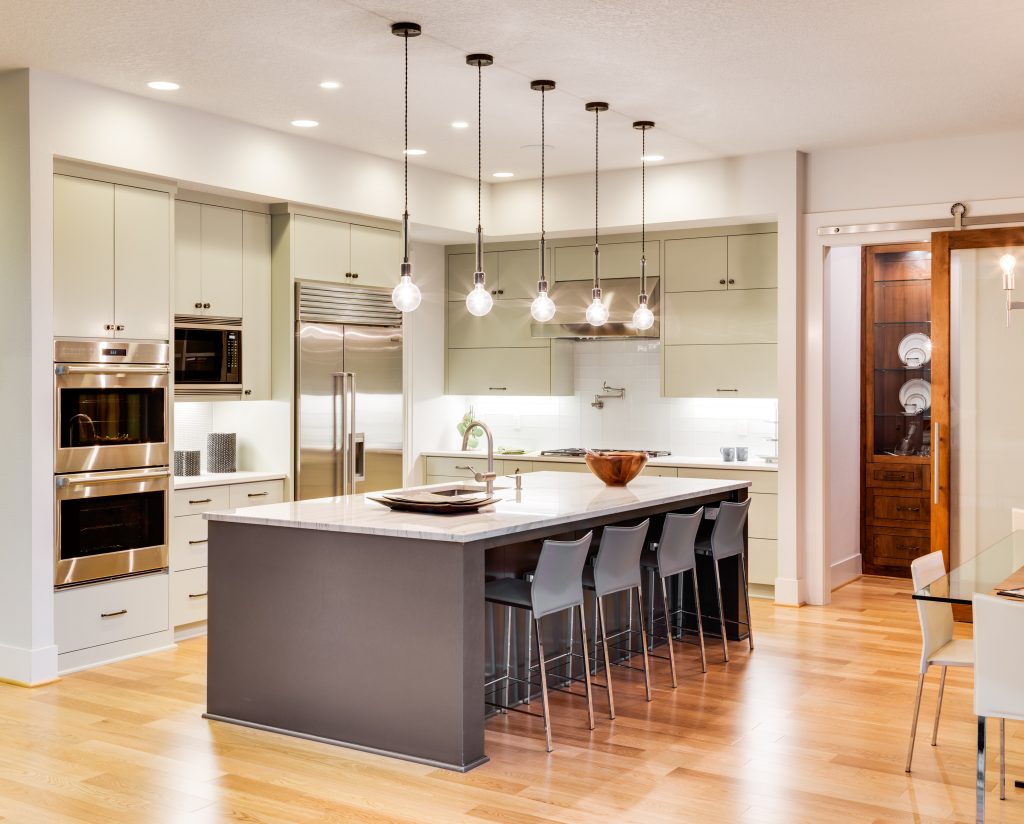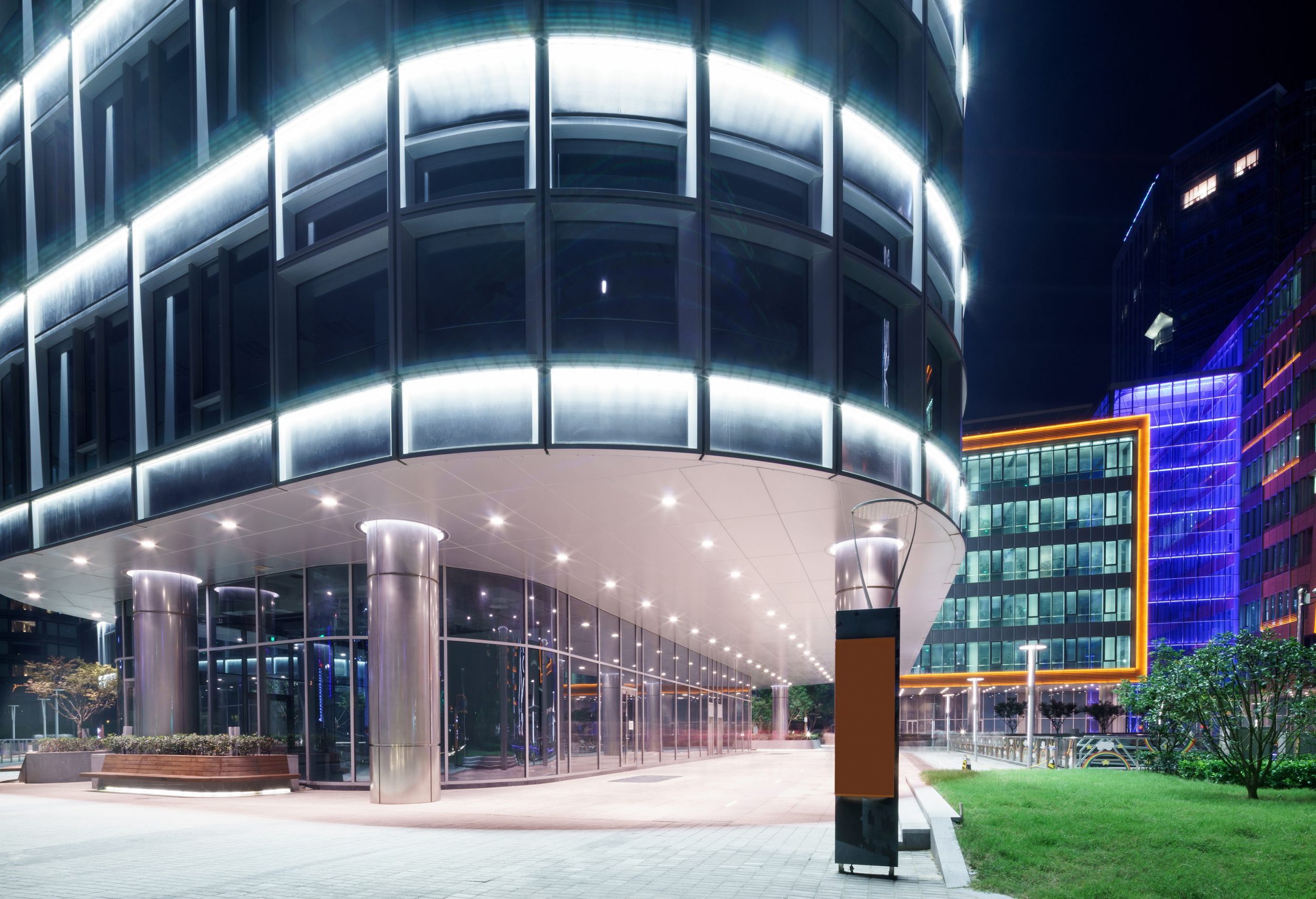COMMERCIAL AND RESIDENTIAL LIGHTING might look similar, but their design, purpose, and manufacturing couldn’t be more different.
Depending on its application, commercial lighting can be customized to fit any facility and its operations. Brightness intensity, maintenance requirements, and warranties are all important factors when looking at commercial fixtures.
On the other hand, residential lighting is pretty simple. It doesn’t need to meet the same requirements as commercial fixtures — like nearly endless hours of operation — so cost and quality are the most important factors to consider when retrofitting a home or outfitting a new one.
To set the record straight, we’re taking a look at the four biggest differences (and similarities) between commercial and residential lighting.
Commercial Grade vs. Residential Grade

First, let’s talk about “grade.” From a manufacturer’s point of view, there is a difference in the grades of different fixtures and lamps. Commercial-grade fixtures are engineered for longer lifespans and longer continuous runtimes. They also usually feature tougher finishes or thicker bodies to stand up to more wear and tear.
Jim Glass, the City Electric Supply (CES) District Manager for Daytona Beach, uses his experience as an electrical supplier to weigh in on the differences between commercial and residential grades that electricians may not know about.
“A huge difference between commercial and residential LED lighting is the quality of the LED modules themselves and their ability to put out consistent lumens and color,” Jim Glass said. “The LED modules are rated by what is called a BIN rating. Typically, commercial LEDs are made with higher bin-rated LEDs, which equate to higher quality and cost.”
As a result, commercial-grade fixtures generally see better warranties. Not only is it manufactured with durability in mind, but its warranty is also factored into its cost-savings, which is huge when it comes down to a commercial facility retrofitting their building with energy-saving LEDs.
Residential-grade fixtures are manufactured to be as affordable as possible while still meeting energy-efficiency standards. Because they don’t need the same requirements as commercial fixtures — like nearly endless runtimes — they are built with cost-effective components. Residential-grade products also have shorter warranties because replacing the fixture or lamp is more affordable and cost-effective for homeowners than manufacturers pricing in longer, comprehensive warranties.
Along with warranties, the biggest difference usually lies in the LED chip and driver. Commercial-grade products are engineered specifically for demanding applications, meaning they have improved drivers, heat sinks, LED chips, and lenses. Although they cost more, they are generally better and last longer.
1. Purpose
The biggest difference between commercial and residential lighting has to do with its purpose.
Focused on complementing a home’s aesthetics and interior, residential lighting is typically used as ambient light. It makes a home feel more functional and more comfortable, while commercial lighting is more focused on creating an environment that is both productive and safe. Because of this, the lumen output inside a home versus an office or even a commercial facility will naturally be much lower and trend toward warmer colors.
On the other hand, commercial lighting is much more varied than residential lighting. Whether it’s illuminating a workspace to improve employee health and wellness or illuminating a facility for maximum visibility, the commercial application will decide the luminous intensity.
2. Durability
LED luminaires are generally much more durable for commercial installations than residential installations. Long service hours and more demanding conditions require a manufacturer to build commercial LED luminaires with additional features, like an IP rating to stand up to dirt and water.
In homes, durability isn’t a huge factor in the design of a residential LED luminaire, although it’s still resistant to external shocks like jarring or bumping. Its lifespan is also much longer than other lamps and requires little-to-no maintenance besides replacing the luminaire itself.
If you’re looking for the best of both worlds, CES District Manager Jim Glass has some advice that electricians may not have heard before.
“The industry has seen dozens of new companies emerge with the LED revolution we’ve experienced the last five to 10 years,” he said. “Be sure the products you are considering buying are from a reputable manufacturer that stands behind their products. Quality products made by reputable manufacturers are not always the lowest in cost, but you have the reassurance that they will stand behind their products.”
3. Cost
We’ve mentioned it before, but cost is another big difference between commercial and residential lighting. From improved durability to additional features, commercial lighting products simply cost more to manufacture.
For homeowners, these additional features are unnecessary. Instead of outfitting residential luminaires with unnecessary features, they’re built to meet the most important specs needed inside a home, like improved energy efficiency and longer lifespans.
However, that’s not to say there’s nothing innovative happening inside the home. Wherever you look, this industry is shaped by innovation, and contractors and customers are excited to pay a little extra for improved features.
“Lighting controls and connected lighting are some of the more exciting products evolving in both the commercial and residential spaces,” said CES District Manager Jim Glass. “Occupancy sensors and ambient light sensors with integrated dimming capabilities are examples of these controls that are now offered by many different manufacturers.”
“In addition, there are many platforms now that offer either Wi-Fi or Bluetooth connectivity, giving you the ability to control your lights from a mobile phone app or a software package on a computer. All of these features are important in lighting nowadays, and its impact on upfront cost is negligible when you look at savings over the long-term.”
4. Lighting Design
In commercial spaces, lighting is focused on increasing efficiency in both cost and energy while improving safety and wellness for employees. Commercial color temperatures are generally around 4000K.
Although residential lighting changes throughout the interior of a home, most lighting trends toward 3000K, especially in bedrooms, to create a relaxing environment. Depending on the lighting in areas such as kitchens, bathrooms, garages, or laundry rooms, the lighting usually skews toward a higher luminous output.





